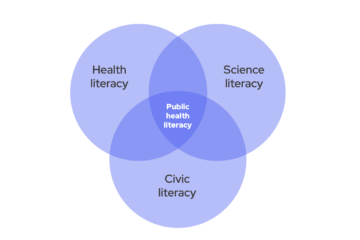As the only federal agency solely dedicated to protecting the nation’s safety, health, and security, the Centers for Disease Control and Prevention (CDC) plays a leading role in building the strength of the public health workforce. While many people know the CDC for its response to infectious disease outbreaks, much of its work focuses on prevention — helping to protect communities from disease, reducing chronic illness, and anticipating and mitigating future threats.

Gabrielle Benenson, CDC Center for Surveillance, Epidemiology, and Laboratory Services
One of the behind-the-scenes ways the CDC impacts local communities is by providing and vetting training for public health professionals. We talked to Gabrielle Benenson, education and training services branch chief in the Division of Scientific Education and Professional Development at CDC’s Center for Surveillance, Epidemiology, and Laboratory Services, about how the agency determines the value and impact of trainings.
Q: How does the CDC measure the effectiveness of trainings?
A: We have a set of eight Quality Training Standards that serve as a benchmark for quality training excellence at the CDC. The standards help ensure that the CDC develops, delivers, and procures quality trainings to better serve public health professionals. The standards are based in educational science and are broad enough to cover trainings for all audiences and budgets.
Q: Why were the standards created?
A: Over the past few years, quality training has become a priority for the public health workforce, and the CDC has worked with several partners to develop an action plan that prioritizes areas for workforce training. These priorities were informed by the 2014 Public Health Workforce Interests and Needs Survey (PH WINS) and the 2017 report from the National Consortium for Public Health Workforce Development, “Building Skills for a More Strategic Public Health Workforce: A Call to Action.” The survey and the consortium report identified the need for “effective and engaging training.”
Q: What needs or gaps do the standards fill?
A: The science of learning, which includes instructional systems design and educational psychology, helps us understand what makes a training effective. But not everyone who teaches or develops training has a background in this area of science. We found that no agency-wide standards existed and decided that creating a set of standards that could be easily adopted would benefit programs across the CDC and other public health professionals. These standards and tools for application can help anyone who develops and delivers training use education science to make training more effective.
Q: What came before the current CDC standards, and how did you refine the standards into their current form?
A: As an active participant in discussions and efforts with other workforce partners to address quality training, the CDC built on what other partners had already done. The first step was to review existing public health training standards and tools.
From 2015 to 2016, the de Beaumont Foundation, St. Louis University, and Quality Matters partnered to develop a draft set of public health workforce e-learning quality standards, with input from an advisory group made up of representatives from public health and academic institutions. Beginning in 2016, the National Network for Public Health Institutes and Public Health Learning Network used data from surveys, interviews, and an environmental scan to inform development of a review tool and a peer review process to assess e-learning for quality, which can be found on the Public Health Learning Navigator website.
To make sure our standards could be used for any type of training beyond e-learning, we reviewed additional standards, including those provided by TRAIN.org, Quality Matters, and those already used by the CDC for e-learning, training promotion, and accreditation.
The set of eight standards was finalized in 2018. A working group convened by the CDC to review existing quality standards and develop a practical set agreed to adopt the standards agency-wide. The working group is providing communication across the CDC to raise awareness, developing tools to help with implementation, and building the standards into a variety of existing training processes.
Q: How you see the standards being used — both to review courses and as a guide for new course development?
A: The primary audience for the standards is anyone at the CDC who develops, delivers, or procures training. The standards are intended to guide development of training and are best used early in the process. A checklist has been created and posted at www.cdc.gov/trainingstandards to help training developers inside and outside of the CDC apply the standards to their training development.
These standards can help learners make decisions about which trainings to take, when they have limited time and many options. For example, we partnered with the Public Health Foundation to add the standards to CDC TRAIN. A CDC course provider can answer eight yes-or-no questions that align with each of the standards. If all eight questions are answered with a “yes,” their course meets the standards and an icon is added to their course description in TRAIN. Learners can easily filter search results within CDC TRAIN to show courses that meet the CDC Quality Training Standards.
We would love for other organizations to adopt the standards and provide quality development information for their courses as well. Along with star ratings from learners who have taken the courses, a learner has more information when choosing a course.
In addition, as working group members are actively sharing the standards with their programs, there may be other ways they are used, such as in funding documents to ensure the standards are met in trainings procured by the CDC or in development processes within training teams.
For more information on the Quality Training Standards and to see examples, visit www.cdc.gov/trainingdevelopment/standards/standards.html.




